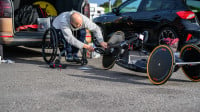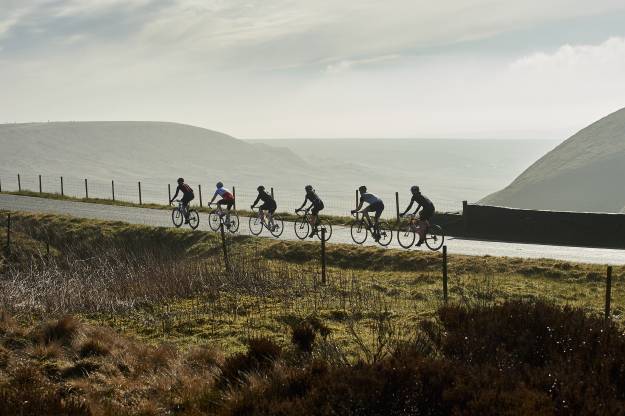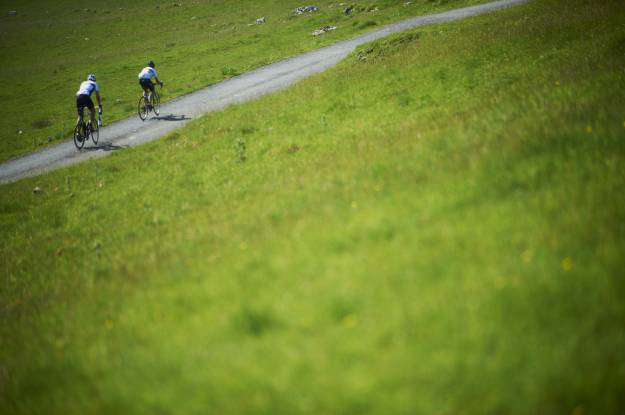Scottish inventor John Boyd Dunlop made the first practical pneumatic tyre in 1887 to prevent his son getting headaches while riding his bike on rough roads. Since that day, air filled tyres have allowed cyclists to race over the rough pavé of Northern France, tackle rocky and muddy trails and to enjoy a smooth ride on tarmac. With that familiar hiss though, our air cushioned dream can quickly turn into a ride halting nightmare.
Punctures always seem to happen at the worst possible times, such as when you are running late on a commute, on a freezing wet training ride at the top of an exposed hill or in an important event. Unfortunately occasional punctures are an inevitable part of cycling but, with practice, can be quick to fix and there are steps to take to avoid getting as many.
Types of puncture
There are two main types of puncture. The first is a penetration puncture where a foreign body such as a thorn, nail or flint goes through the tyre. These type of punctures can range from a small thorn that will result in a tiny hole that will slowly leak air, to a large sidewall gash caused by a sharp rock that will cause instant deflation.
The second type are impact, pinch or snakebite punctures. These happen when you hit a sharp edge, such as a pothole, and the inner tube gets pinched on the rim causing it to puncture. These punctures are characterised by the two parallel slits in the inner tube they cause, that give them their snakebite name.
Tyre choice
Super lightweight tyres can be great for that race day performance boost when every second counts, but the small gains they give you has to be weighed up against the greater losses you could accumulate fixing flats. For day-to-day training on the road and sportives, there are plenty of tyres available with puncture protection technology, such as Kevlar reinforcement, that aren’t too heavy.
Consider heavier duty tyres for winter training duties but be aware that cheaper ones will often have a very hard rubber compound that can be slippery. Urban commutes may require even more robust tyres to combat broken glass. Mountain bikers need to consider the trails they typically ride on. If they are rocky, especially with flints, you will need tougher sidewalls.

Tyre pressure
Checking tyre pressure should be part of your pre-ride routine using a track pump with an accurate pressure gauge. Tyres will have a recommended inflation range printed on the sidewalls but don’t just pump them up to the maximum. Correct pressure is dependent on rider weight and road or trail conditions. You will need to experiment and seek advice to find what pressure works best for you.
As most of your weight goes over your rear wheel, it is normal to run it at a higher pressure than the front. An under-inflated tyre will be far more prone to pinch flats and thorn punctures but an over-inflated tyre is more likely to be damaged by sharp flints as it won’t deform around them. Mountain bikers and cyclocross racers are often forced to run very low pressures to maintain traction and, because of this, using tubular or tubeless tyres will negate the risk of pinch flats as there is no inner tube.
Maintenance and routine checks
As well as checking pressure, before every ride, carefully inspect your tyres. Run your hands over them to find any unusual bulges or foreign bodies and look carefully for embedded shards or glass or flints that haven’t yet worked their way through to cause a puncture. As part of your post-ride clean, wipe your tyres off and again inspect for damage. It is always better to find a problem and sort it then rather than when you are heading out the door for your next ride or a couple of miles down the road.
Sealants and tape
Liquid sealants go inside the tyre, inner tube or tubular and will seal punctures up to a certain size. They are often latex based and some also contain small particles that aid sealing. It is possible to buy inner tubes with sealant already installed and, especially if you mountain bike in thorn ridden areas, these can be a convenient solution. The downside is that they are expensive and they add rotating mass to your wheels.
For most tubeless setups, using a sealant is part of setting the tyres up and making sure that the system holds pressure. Once inflated, the sealant is then there to seal punctures. Setting up a tubeless tyre with sealant can be messy and does make changing tyres to suit trail conditions inconvenient. However, for mountain biking, the advantages tubeless tyres offer definitely outweigh these cons. It is also possible to use a sealant in tubular tyres as a preventive measure but it is wise to check manufacturers recommendations as some ammonia based sealants will attack and degrade the inside of the tube.
You can also buy puncture resistant tape and strips that sit between the tyre and the inner tube adding an additional layer of protection. With modern tyre protection technology and materials though, these are usually an unnecessary addition that do add significant weight to your wheels. They are only probably worth considering if you mountain bike on very thorny trails and don’t want to make the change to tubeless tyres.
Riding technique, line selection and road positioning
Some riders just seem more prone to punctures and, although in rare case this can be down to pure bad luck, skill does play a significant part. Especially when riding off road, learning to “ride light”, using your body to absorb shock and picking smoother lines, all reduce the risk of flats. On the road, having good bike handling skills will also help prevent punctures. They will allow you to avoid obvious puncture hazards such as gravel or broken glass and, in extreme cases, bunny-hop a bad pothole.
If you are riding in a group, make sure that major road surface hazards are pointed out and that the warning, usually pointing at the spot on the road, is passed through the group. Use common sense and discretion if you are the front rider. You don’t need to point out every single bump and blemish on the road, just any major hazards. Finally don’t ride in the gutter. Not only will it encourage cars and other vehicles to attempt to squeeze past you but puncture causing road debris tends to gather there.
Weather
It is no coincidence that punctures are more common in wet weather. This isn’t just the gods of cycling torturing you, although it can feel like that at times. More grit and debris is washed onto the roads and the water acts as a lubricant for objects penetrating your tyres. We’re not saying avoid riding in the wet but, when the weather does take a turn for the soggy, it’s even more important to bear all of the above information in mind to avoid picking up punctures.













